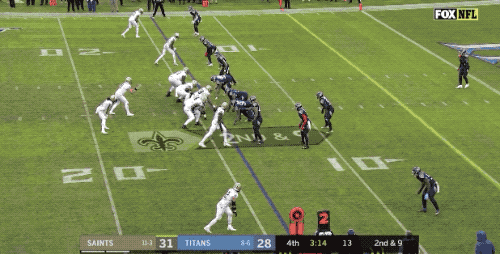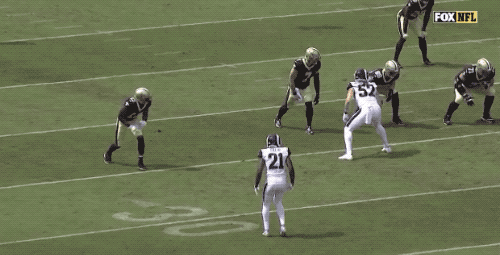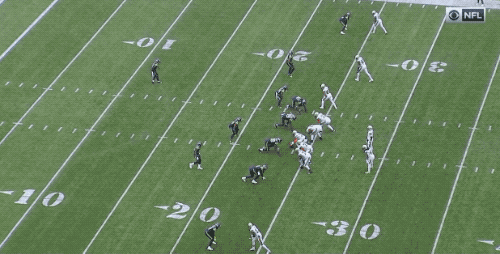Can Michael Thomas Keep This Up with an Aging Drew Brees?
In an off-season where the Saints signed a few big free agents (including the return of safety Malcolm Jenkins and arrival of Emmanuel Sanders), their biggest was the re-signing of quarterback Drew Brees to a new two-year deal.
Brees, 41, is following in the footsteps of now NFC South rival Tom Brady by staying alive as a starter in his early 40s in a new generation of up and coming stars on the more mobile side of things. And much like the GOAT himself, he’s got a superstar connection with one of the league’s most talked-about receivers.
Since his days at Ohio State, Saints wideout Michael Thomas has been catching everything coming his way. After all, he has the most receptions through a player’s first four seasons in NFL history, and is also the reigning Offensive Player of the Year after setting the single-season record for receptions. He and Brees have connected 29 times in the end zone in the four years they’ve been together, and it’s made all the more dangerous with the short passing game implanted by head coach Sean Payton.
Both are coming off immensely successful fantasy seasons; Thomas’ 149 catches, 1,725 yards, and nine touchdowns made him the league’s WR1 in fantasy points (225.6 on FantasyData). Meanwhile, Brees, while finishing 21st among QBs in points (2,979 yards, 27 TD, four interceptions, 224.76 points), was on pace for the league’s QB4 as he only played in 11 regular-season games.
Thomas finished 26th overall in fantasy points, with Brees right behind him at 27th.
Yet with all the success he’s had, Thomas has been a more polarizing figure recently, not just because of his tweets, but because skeptics land that he doesn’t run a versatile route tree in terms of distance. Indeed, Thomas had an average depth of target (aDOT) of 8.3 in 2019. That’s lower than Jarvis Landry, DJ Moore, Golden Tate, and other short-area receivers.
On the 2019-20 Deep Ball Project, Thomas was only targeted on three throws of 21+ yards when Brees was the quarterback. This leads us back to Brees, someone who at his age fell off completely as a deep passer in 2019. The Saints offense has still been lethal at exploiting the short/intermediate areas of the field, but this can help explain why Thomas has not had much experience as a vertical receiver.
Now we get into the most common criticism of Thomas: Can he still produce at a high level with an aging Drew Brees or without him? I do think this complaint is unwarranted, as Thomas was able to produce when Teddy Bridgewater was called in to hold the fort while Brees recovered from a thumb injury. In those six games (or technically speaking, 5.5), Thomas caught 52 passes for 640 yards, three touchdowns, and 106.7 yards per game.
I think that answers the aforementioned question, but to dig a little further, let’s take a look at a bit of Thomas’s tape from 2019.

Yes, Thomas is guilty of his heavy involvement on slants and shallow crosser routes, that much is true. What’s also true is he’s so damn good at executing in these areas. His footwork is violent and his jerky route break seems to always catch defensive backs by surprise. This move was made on the very same catch that set the single-season record, nearly resulting in a touchdown.


More so than most receivers in the league, the amount of space Thomas is able to create off these route breaks is downright sensational at times. He’s able to cut on a dime in both of these plays, and his ability to stop himself without losing traction really helps in creating safer, easier throws for his QB. While many would wish to see more of this at a vertical level, little details like this make Thomas much more than your garden variety receiver.
In addition to slants, Thomas is also insanely good at separating on curls and comeback routes. One could claim that he’s the absolute best receiver on the curl route, and I just might go so far as to make that claim. He’s very balanced on these plays even when physics suggests his momentum normally wouldn’t be stopped as quickly as he’s made it out to be. It sounds trivial, but it really makes a difference for Thomas in terms of production and quality.

Thomas at heart reminds me of Michael Crabtree. Before you take this as some kind of attack for comparing him to a “sorry receiver”, keep in mind Crabtree was one of my favorite receivers during his time in Oakland. His blend of contested catch greatness, tight sideline footwork, separation at the top of his routes, sharp jabs, and spatial awareness at the catch point made him a unique, brutally underrated player in his prime.
Thomas has Crabtree’s spirit inside of him in this regard. He’s also the safety blanket and the volume-heavy receiver of the Saints – it’s a rarity to see those two in combination. He executes a deadly head turn on this play while showing a good deal of patience after the catch before spinning on the Seahawks corner.
What Michael Thomas may lack in versatility he’s easily made up for in playing at a high level for how he’s used. His sudden movement is apparent before and after the catch, and he’s arguably the smoothest route runner in football right now. I do agree that testing him by expanding the depth he’s targeted at would give us a better idea of if he can have said versatility, but for how Sean Payton uses him, there are very few players at this point in time who can actually stop him.
Regardless of whether Drew Brees retires after 2020 or not, I think Thomas can still be a quality receiver and continue to put up cheat code numbers as long as he’s got Payton by his side. And even if his yards per reception is lacking in comparison to other NFC South route running masters, he’s still a huge asset for getting those highly-sought-after PPR metrics.
- 2023 NFL Draft: IDP Dynasty Fantasy Football Winners and Losers from the NFC - June 1, 2023
- 2023 NFL Draft: Best Fits for Anthony Richardson, Bryce Young and CJ Stroud - April 19, 2023
- Fresh Off the Bye Week: Bengals, Jets, Patriots and Ravens - November 18, 2022


































































